Animation Sensation: UROTSUKIDOJI: One Of The Most Shocking Exports Of Japan

If there is one word that can sum up Dallas…
The screen is dark and all that is heard is a deep and booming voice, accompanied by a haunting choral melody, that the viewer is a member of an ignorant race. A few blares of flashing light show an orgy of sex and violence amidst the explosion of volcanic fissures. This is not the realm of humans, but of beastly demons engaging in all manner of sexual acts. Then, without warning, a heart is ripped out and crushed only to have the blood from it consumed by a mouth filled with jagged fangs. Urotsukidoji: Legend of the Overfiend begins with all of its cards on the table, and consider the opening scene your first warning because it only gets more shocking from here.
I discussed this film briefly in my book, Anime Adrenaline, a few years back. So why discuss it again? Because this is one of those animated films that left an impact on not only me but on the anime fan community for decades since its release to American shores back in 1993. Before it exploded onto the screen for American audiences with a foreboding NC-17 rating, the far more violent 1987 OVA (Original Video Animation) three-and-a-half-hour erotic horror epic was making its rounds and receiving controversy.
Japanese animation is no stranger to the world of controversy. Such adult classics as the cyberpunk film Akira (another animated film I hope to discuss here), the pornographic shock-schlock horror Bible Black, and even kiddie fare such as Pokemon have made many a soccer mom and religious televangelists clutch their proverbial pearls in white-knuckled indignation. But few films, animated or not, have not had the same kind of depraved and shocking lasting impact that Urotsukidoji: Legend of the Overfiend has. And I say film because the focal point of this segment will be the limited-run NC-17 theatrical cut version of Urotsukidoji. This is the version most American audiences of anime are best acquainted.
Porn With A Plot!
Adult animation from the land of the rising sun has been given a bad rep, and watching some of them, one can see why. Mature anime of a sexual nature, known as hentai, is beyond bombastic. Hentai can reach levels of depravity that would make a brothel owner blush and has, unfortunately (or fortunately for some of the trolling fans on the dank halls of the internet), given Japanese animation, as a whole, the unfounded reputation of just being “nasty cartoons.”
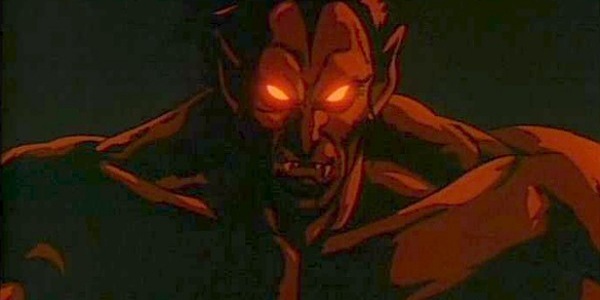
When Urotsukidoji: Legend of the Overfiend reached the United States, many audiences were unprepared for copious amounts of sex, violence, and “tentacles” (more on that later). But what many fans of this strange and burgeoning Japanese pop-culture medium—myself included—were not expected of such a film is for it to have an honest-to-goodness plot. Good gravy! Hardcore horror erotica to have characters one can care about and a gosh darn beginning, middle, and end—what is the world coming to?
So what is the story of this infamous anime? Legend has it that every 3000 years, the human world — known as the Ningenkai — is united with the Makai and the Jujinkai, the world of demons and man-beasts, respectively. Who combines these three worlds? The Chojin, a God above all other gods, is also known as the Overfiend. Nobody has seen the Chojin, and legend has it that his unification will bring everlasting peace and prosperity to the three worlds. Amano Jyaku, a proud man-beast warrior, is sent to earth to investigate the prophecy that the Chojin will be born from a human couple. Amano’s faith is tested when demons from the Makai are sent to destroy the Chojin from coming back so that the three worlds will not unite. The Makai like their blood-soaked and degenerative world just the way it is.
Urotsukidoji stands out because the plot is not a mere stand-in for the sex and violence on display; there is an actual effort put into the story. Not a copious amount of effort, but effort nonetheless. Worldbuilding and character development are considered, especially when considering one of the main leads — Amano Jyaku.
Amano Jyaku: Anti-Hero Turned Hero
Take a dash of Kaneda from Akira, a pinch of David from The Lost Boys, and a touch of an 80s punk kid; throw it all into the cooking pot of characters, and you get Amano Jyaku. Amano starts as a passionate punk, carefree and trouncing around the earth for centuries, waiting for the Chojin to appear. He believes in the Chojin’s return, but even a super-powered demigod has his limits of patience. Everything kicks into high gear when he meets the other two main characters, Nagumo and Akemi—two young human lovers he believes will be the human parents of the Chojin. When he enters the earth, he becomes a rebellious anti-hero, but as time goes on, he develops into a steadfast and faith-driven hero who will do anything to ensure that the Chojin unites the three realms.
On a side note, he also has some of the funniest lines, albeit unintentionally humorous, in the bad English dub. Word to the wise, watch this in original Japanese but if you’re looking for a Mystery Science Theater 3000 roast session — watch the English dub.
Amano Jyaku is the main character of the story. The title Urotsukidoji roughly translates to “Wandering Kid.” It is a strange title for such a lewd work, but it is more symbolic of Amano’s state. He has been wandering the earth for centuries and on the wing-and-a-prayer of prophecy. But the strange thing about Amano and his insistence on sticking around the human realm is that he does not need the Chojin’s return for things to be better.
His home, the world of the man-beasts, is not wrong, and he enjoys it—but it could be better, and so can the other realms. It’s a bit of a flimsy motivation for such a time investment. Still, in this sense, Urotsukidoji is a twisted coming-of-age story where Amano has to leave his lusty ways behind and grow up — and it only took three hundred years for him to do it. Maybe I’m reading too much into this? Quite possibly. But examining some of the other characters makes me think otherwise.
Two of the other main leads, Nagumo and Akemi, are two college-aged lovers who met under some questionable means. Nagumo begins as the college pervert, sneaking into girls’ locker rooms for a “private” show, but his eyes are mainly on Akemi. Akemi and Nagumo are, to put it mildly, not the best-written characters and certainly do not grab the attention of those who would dare watch Urotsukidoji as Amano does. But their story of doomed love is — as far as an erotic horror anime film goes—touching in its way.
Being the human hosts of the Chojin comes at a high cost, and the film pulls no punches to such an emotional weight — almost being saccharine at times. However, I would be remiss to admit that I would understand if you shut off the video after seeing the peeping tom Nagumo act in such a perverted manner, only to have the story expect us to side with him. Turning back now would be understandable because Urotsukidoji is a shell-shocking sledgehammer to the senses and has worse things than voyeurism, but I digress.
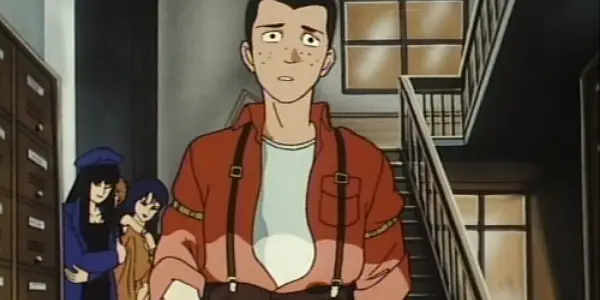
It seems strange that an anime horror porn like Urotsukidoji can evoke any sense of pathos, but it does. One character that comes to such a forefront is Niki Yuichi. Niki is the epitome of the sympathetic loser who always gets the short-end-of-the-stick. He is the school punching bag and is met with vicious abuse. To bring the viewer into what kind of world this poor young man lives in, every time he is mistreated, the colors of the world around him turn into an almost nauseating blue and red tones (colors that Urotsukidoji implements with frequency) with close up shots to exemplify a feeling of claustrophobia. Niki is one of the first humans to be contacted by demons to offer him power. And as anyone knows, when you make a deal with the devil, things do not go so well.
Niki is also hopelessly in love with Akemi, and his jealousy of Nagumo turns into an obsessive hatred, which the demons take advantage of. The deal of the monsters is that Niki must remove his humanity, discard that which makes him a man, and then he will have not only Akemi but revenge against all who wronged him. When the demons offer Niki a magic phallus, the price of power is that he must castrate himself — and in one of the most disturbing scenes in the film, he mutilates his own body for a sense of false power. Even though the castration is primarily off-screen, the sounds and intense animation beforehand make the implication more shocking than any exhibition of full-frontal genital mutilation.
Niki’s change from sheepish whipping boy to a muscle-bound boor of a half-demon is one of the saddest aspects of the film. While he enjoys his superficial sense of power, engaging in hedonism and abuse of those weaker than him—thus becoming that he hated — he is also torn. In one scene, even though he is in the throes of sexual ecstasy, he goes a little too far and hurts his partner in the process. His first inclination is to tell the poor young woman to “shut up.” Still, for a brief moment, he realizes that the girl he is with reminds him of his beloved Akemi and immediately bursts into a tearful apology. Before his complete transformation into a demonic monster, Akemi is most concerned for him, “Niki, you’ve changed; this is not the Niki I know.” Even though he is becoming a monster, he still has a heart because this breaks him, but the allure of power is too tempting, and there is no turning back.
This negative transformation is a common trope of tragic downfall stories, especially regarding someone changing into a toxic being. While observing Niki’s character, I could not help but think of the 1986 film, The Fly, where once nerdy Seth Brundle — during his transformation into the eponymous fly creature — feels a growth of power and confidence due to his newfound strength and abilities. His mind is warped, and he lets the power go to his head, hurting those he loves in the process — and much like Seth Brundle, Niki reaches his untimely end when his hubris becomes too much and is killed for it.
For what is considered a sexploitation anime, it is fascinating that the story does not devolve into a pure power fantasy but as a warning. I believe Niki’s side story in Urotsukidoji is one of the best crafted and shows the tragedy of how dangerous unbridled power can be. The main story of Urotsukidoji tries to tell us something important — even if the overall package is dubious, offensive, and shoddy most of the time.
Less is More — How to Do Animation on A Budget
With such anime films as Akira showing just how amazing hand-drawn animation can be with a massive budget, Urotsukidoji shows viewers what can be done on a shoestring one. This is nothing new, and the anime industry is notorious for creating striking visuals with meager budgets. Unlike the powerhouses in the West, such as Disney, anime studios are not given copious amounts of funding to play around with, and the time constraints placed upon Japanese animators are more astringent. This means Japanese studios have to cut corners and implement animation methods that give the illusion of fancy visuals on a comparatively little cash flow.
Anime tends not to be as fluid in its animation compared to its American counterparts. For example, mouth animation relies mainly on a sparse array of a few flaps, which seems amateurish and lackluster to many audiences in the West. But many anime fans are so used to seeing it that the trend has become second nature and can be ignored. Where American animation is more graceful, with higher frame rates, anime has one artistic flair that the West needs to catch up on — the attention to detail.
Not to say that American animation lacks such technique, but many Japanese animators obsess over the minutia and experiment with what animation can do. There is no decade where wild experimentation was at the forefront than the 1980s — for better or worse. In the 80s, Japan was going through an economic boom, and the entertainment world felt the effects of cash overspread. No matter how outrageous, vile, strange, or out-of-the-norm, it seemed like any anime project was given the green light. After all, producers are more willing to take risks when the money train goes into effect.
The 80s was what I like to call, ‘the great anime experiment.’ Nothing was off the table, and the creative river of pop-cultural juices flowed like a torrent. The 80s was also a decade of decadence, with some outrageously offensive and in-your-face stories on home video. Devilman, Violence Jack, Wicked City, and a vast array of violent direct-to-video shows were brought to small screens in Japan and showed no sign of slowing down such animated carnage.
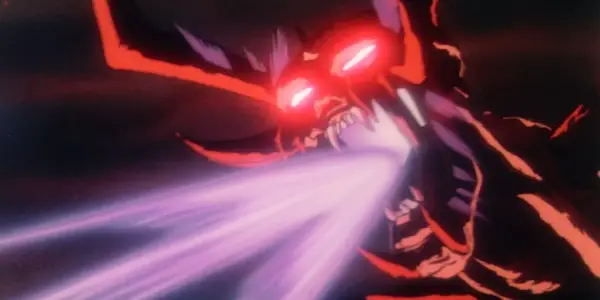
Urotsukidoji was no exception, filled with a drive to see just how far it could push the limits in copious amounts of sex and gore — with the two sometimes not mutually exclusive. But even such vast and violent animated dreams can fall flat if the budget is low. But Urotsukidoji, despite such setbacks, is still visually impressive. The entire work has an almost vulgar beauty to it, with its settings having a grimy feel that adds to the oppressive and doomed tone of its apocalyptic, larger-than-life themes. And anything involving an apocalypse will feature a lot of bombast and things blowing up. Destruction is what Urotsukidoji does best. There is a passion there whenever there is a fight scene or any major monster event in this anime. Admittedly, the animation in Urotsukidoji is not smooth, the frame rates can be choppy, and the character designs are somewhat clumsy and haphazard. There is an overall unpolish to the entire work. But on the other hand, the character designs are also full of expression and spunk, and despite the darker themes of this feature, they sometimes border on being comical.
Gorehounds and fans of splatter-induced horror will also get a kick out of the bloody fight scenes. Bones crack, limbs ripped off, and a comprehensive gleeful, explosive exploration of blood and guts exhibit whenever there is violence on the screen—most notable whenever Amano is on the attack. One of the showstopping battles of the film is when Amano is in his final form, an animalistic demigod trying to thwart the destruction of Tokyo (Japan will never prevent giant monsters from attacking its shores). The decimation of Tokyo is a sight to behold, with a relentless crumbling of buildings and a shocking melding of sex and violence rolled into one.
Without going into detail, the Chojin returns, but he — at first — is a monster of chaos instead of the savior that Amano hoped for. The massive monster destroys Tokyo via a destructive blast of penile projectiles from a series of tentacles. The Japanese collective unconsciousness has some bizarre and wild things poking around! Time to explore the elephant in the room; why Japan has something as offputting as tentacles in some pornography.
How the Fisherman’s Wife Created a Sub-Genre of Porn
In 1814 the famous Japanese artist, Hokusai, crafted a woodblock print called The Dream of the Fisherman’s Wife. It was a strange piece of erotica featuring a woman who was sexually intertwined with two octopi. Believe it or not, the subgenre of tentacle porn in modern-day anime erotica owes its existence to this piece, and Toshio Maeda — the creator of Urotsukidoji — made this absurd form of pornography a household name.
At the time of the publication of the original comic series of Urotsukidoji, Maeda was under the thumb of Japanese censorship laws. One of the rules was that any sexual act could not show genitalia in full view and had to be blurred out or censored — a mandate that still exists today. Being the trailblazer that he is, Toshio Maeda wanted complete control of his erotic works. Hence, he utilized his stories of human women having sex with monsters with giant and invasive tentacles. It was a loophole; the monsters were not humans, so they did not have human genitalia—they were creatures who took advantage of mortal women.
Humans getting freaky with creatures is nothing new. Mythology is replete with stories of human women (and men) doing the nasty with monsters and mythical beasts. Japanese art might be one of the few that put such a mythological sexual staple into graphic detail. Still, everyone from the Greeks to the ancient Hebrews has stories of paranormal beings getting it on with humanity. Don’t believe me? Peruse any romance section of a bookstore, and you will see a plethora of paranormal romance or erotica books on sale, and these novels sell in the millions.
Urotsukidoji takes this fascination and turns it on its head, giving the viewer a glimpse into the fear of the unknown. It is no surprise that in the plot, it is the world of the humans ignorant of both the demon world and the world of the man-beasts. This primordial fear of unwanted ravishing from creatures from unknown realms has been with us since the dawn of time, most notedly from a female perspective. Human women are viewed as mere sexual playthings for the demons to indulge in, and even men are not safe from the demon’s advances.
Although the crude technical quality of Urotsukidoji is omnipresent, the frightening appeal has not lost its weight. It has morbidly stood against the test of time, even against some of its more well-received and masterfully crafted anime counterparts. Fear is a powerful emotion, and Urotsukidoji has buckets of it along with buckets of certain bodily fluids.
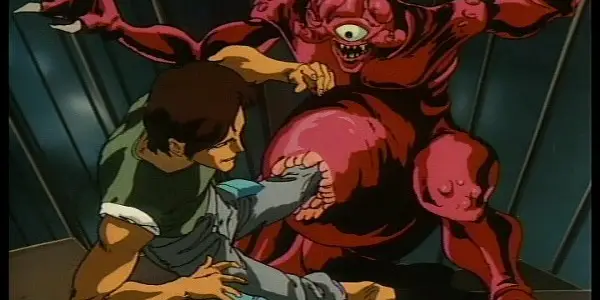
Several audiences in the West have made the query concerning the strange fetishes that come out of some Japanese entertainment. There is a simple explanation as to why. Japan is a society with an extensive history of Neo-Confucianist values were being proper, polite, and controlled are extolled as some of the highest virtues. The Japanese, as a whole, pride themselves on their clean appearances and indulgent systems of etiquette and hard work. Unfortunately, this form of social browbeating has led to a culture of shame and repression since, in Japan, the values of the group and holding to conformist social mores are paramount. While Japanese society, on the surface, stresses ethics, as mentioned above, Japanese culture recognizes that people need to let off steam. I like to call it “the work hard play hard” ethos. When social obligations have been met, a Japanese citizen can indulge in whatever their heart desires — if it does not harm another or hinder their ability to be a productive member of Japanese society.
In the West, many people are encouraged to speak what is on their minds (at least compared to Japan), but not so much in Japan. So unless someone is with their closest friends, telling that story of how you hit it off with the bombshell at work in lewd detail while in public is not encouraged. But behind closed doors, in the world of Japanese adult entertainment, there are no limits, and thus there is an outlet for such unspeakable desires.
The Audacity of Toshio Maeda
I met Toshio Maeda some years ago after reading his work. He was an amicable guy who beat the system of Japanese censorship and came out on top and making his name as one of the forerunners of manga erotica and horror. Looking at work like Urotsukidoji, it is not hard to see why. Using the word “audacity” to describe Toshio Maeda is not meant to be a disservice but as a proverbial pat-on-the-back.
With all of the bloody disembowelment, sexual violence, gratuitous language, skull-crushing fights, and the overall depravity shown on screen, Maeda dares to impart to those consuming Urotsukidoji—a moral message. Other horror flicks have tried to argue ethos talking points, such as the Saw franchise. With its terminally ill serial killer capturing people he believes to be immoral who cannot “appreciate life,” teaching them a lesson about how to be better people; by torturing and murdering them in the most graphic ways. Hardly a paradigm of goodness as a character. The Saw films are not the best medium for a symposium on ethics.
Urotsukidoji, in all fairness, is along the same vein. What could anyone learn from an animated film for an adult audience that even most adults would find so extreme? It is worth keeping in mind that Urotsukidoji is in the realm of an avant-garde cult movie. And while never going to be an anime film that reaches the heights of popularity of worldwide acclaim such as a Hayao Miyazaki movie or become a pop-cultural icon like the Pokemon franchise, Urotsukidoji has a cult following for a reason.
Urotsukidoji is bombastic and brutal art. It may be low-brow and in-your-face with its content and dependent more on shock value violence than what is considered acceptable by most standards of visual media, but as with all art — it has a method to its madness. Beneath the blood and tentacles lie a story that warns what happens when depravity takes hold of the world. The reckoning of the Chojin is Old-Testament in his punishment throughout the story and warns the viewer what happens when hedonism becomes the norm. In almost every scene where a character is gored, assaulted, or violated—they more often than not are someone who has a less than savory personality or sometimes are literal demons. It is harsh retribution, an old-time religionists’ wet dream. In the world of Urotsukidoji, desperate times call for desperate measures. The name of the game is “repent before it’s too late.”
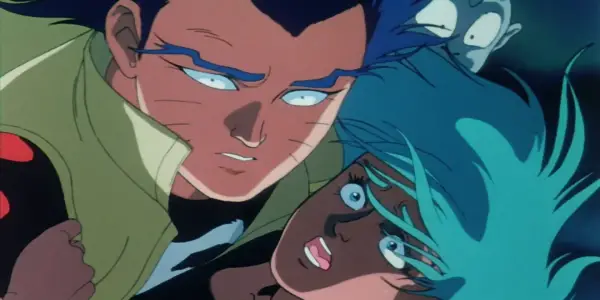
I am torn about this film in many ways. On the one hand, I find it a fascinating apocalyptic fantasy with some surprising character development. On the other hand, I admit why many would want to stay far away. It is a stretch for me to say that Urotsukidoji could never be anything but a work of shocking horror porn trying to masquerade as a warning. But then again, erotic horror is nothing new in art. I read the Bible growing up, and I was exposed to violence — both sexual and otherwise — that would give the crew that worked on Urotsukidoji some severe competition. The Bible (especially the old testament) was the first splatterpunk horror story; Urotsukidoji continues that long mythological tradition.
Urotsukidoji was successful enough in Japan to garner several sequels, but none of them had the same impact and became more gimmicky. The second feature, Legend of the Demon Womb, ups the ante with its sexual violence and ridiculous plot. It is a haphazard work that most fans agree does not fit into the overall canonical narrative of the three other films. Two more films, Return of the Overfiend and Inferno Road, respectively, are not based on any work by Toshio Maeda and instead are original features.
I agree that the three sequels after Urotsukidoji: Legend of the Overfiend are a resounding, shoulder-shrugging, “meh.” As for the first one, I am not alone in my viewpoint that it is worth seeing if you can stomach it. The Erotic Anime Movie Guide by the famous Japanese animation scholar, Helen McCarthy, states that it is a “formative work in the hentai genre.” Even the British television station Channel 4 voted it one of the 100 Greatest Cartoons. No easy feat on both accounts, but your tolerance and mileage may vary. Urotsukidoji is gruesome, hard to sit through, and not for the easily offended.
But I am willing to wager that that is the point. Art, be it an animated film or a painting, is not always there to make one feel good. It can be used to horrify, show something ugly within us, or make us think. Urotsukidoji did all three for me, just from watching the NC-17 theatrical version. I have seen the uncut version, and Chojin help you if you ever get your hands on that copy!
(Urotsukidoji: Japan, 1989; United States, 1993)
What do you think? Have you seen Urotsukidoji? Does it deserve a second look or is it just shock-porn of the lowest common denominator? Let us know in the comments below!
Watch Urotsukidoji
Does content like this matter to you?
Become a Member and support film journalism. Unlock access to all of Film Inquiry`s great articles. Join a community of like-minded readers who are passionate about cinema - get access to our private members Network, give back to independent filmmakers, and more.
If there is one word that can sum up Dallas Marshall, it would be weird. He is a strange fellow who is also a writer, anime nerd, and film buff who can also talk for hours about mythology and out-there literature. He has been sighted at local used bookstores perusing for horror books and manga. He has also written a book about Japanese animation called Anime Adrenaline! Which can be found on Amazon. You can also catch him on his own website at www.Dallasthewriter.com













